The Mike Toole Show
I've Got You, Man
by Michael Toole,
Originally, the plan was to call it “Shadow Knights.” Later, it became known as “Science Ninja Team Birdman.” This title was finalized enough that it was stamped on the label of the original master copy, but in the end, that's not what Tatsunoko called the show. They called it Science Ninja Team Gatchaman, because a hearty “ga-TCHA!” sound is what happens when two great big machines smash into each other. It's exciting, right?! God, I love the Japanese language's tendency towards onomatopoeia. It's so much harder to get away with that in English!
I touched on Gatchaman for a bit in my Tatsunoko column, but I figured the much-loved tale of five teenaged scientific ninja in color-coded bird costumes would need its own piece sooner or later. After all, the name's been all over the papers in the past year, thanks to new TV entry Gatchaman Crowds and the high profile live-action film from Nikkatsu. But I'd better start by explaining how Gatchaman made it to these shores. In short, a guy named Sandy Frank got his hands on it.
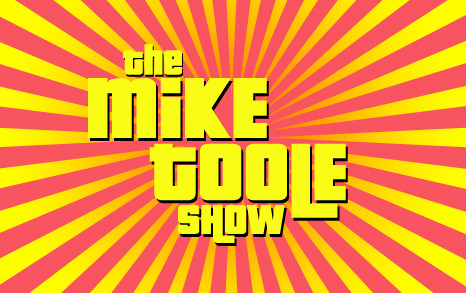
I watched the puppy episode of Gatchaman again this week. I never get tired of it. Lots of long-running shows have a couple of particularly prized episodes, known for either being really good (the Thanksgiving episode of WKRP in Cincinnati, the “I am the one who knocks” episode of Breaking Bad) or really bad (the Happy Days where the Fonz does a waterski jump over a shark puppet, hence the term “jumping the shark”). The puppy episode of Gatchaman (its actual title is “A Critical Moment for the Science Ninja Team”, but let's face it, it's the goddamn puppy episode) is in the latter category, but it's still kind of awesome. Here's the thing: the first time around, Sandy Frank skipped over it.

Here's how Science Ninja Team Gatchaman, a morally upright but savagely, hilariously violent cartoon about super-science's struggle with a megalomaniacal alien force, made it onto American TV in a time when nearly no other Japanese animation was finding its way onto our airwaves. This guy Sandy Frank, a TV producer, was looking for a way to cash in on the Star Wars fad. Star Wars, arguably the first modern blockbuster, had already spawned scads of imitators within a couple of years of its release—you know, generally riveting, compelling fare like Battle Beyond the Stars, Star Crash, Message from Space, and Battlestar Galactica. Frank's stock in trade was television syndication, so he needed a TV show that he could try to associate with Star Wars stuff. Tatsunoko's flashy action cartoon didn't have laser swords (yet), but it did have futuristic weapons and vehicles drawn by Mitsuki Nakamura, throngs of identically-clad bad guy soldiers, and a team of five dashing young heroes. (Well, three of them were dashing, at least.) Frank and his people got to work, retitling the show Battle of the Planets (Star Wars à Planet Battle à Battle of the Planets, get it?), aggressively trimming out violent bits and replacing them with their own filler animation, rewriting the scripts so amazing scenes of city-wide destruction happened on other planets populated by robots, commissioning an awesome new theme song by Hoyt Curtin to replace the awesome old theme song by Masato Shimon, and dropping 20 episodes from the run. After all, Gatchaman ended, and how would Frank be able to keep selling a show that had a definite, specific ending? Sadly, the puppy episode was one of those 20 that got cut.
Despite its utterly bowdlerized nature, Battle of the Planets was a notable hit, sticking to syndicated kids’ TV for a good six or seven years. Frank's company licensed a tiny avalanche of branded goodies, like comic books, coloring books, and puzzles, and thanks to Frank's experience selling overseas, successfully packaged and sold their version of the show to partners all over the planet. That's the funny thing about Frankensteined-together shows like Battle of the Planets, Robotech, and Voltron—they're so easy to sell on after their American broadcast that they often become the definitive version in many other parts of the world, as well. A personal favorite bit of ephemera: the Britain-only BOTP comics, which feature compellingly off-model versions of our heroes. They kinda look like weird football players, or something.
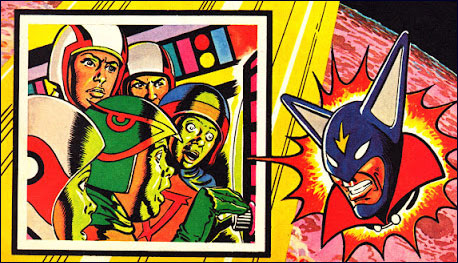
But while Gatchaman was clumsily rebuilt to remove the best parts (i.e. the many, many murders that team Gatchaman tend to commit for the sake of justice), it was still kinda neat. It preserved a lot of the action and music from the original, and featured something of an all-star voice cast, from radio DJ and voice-of-Shaggy Casey Kasem as leader Mark to far-traveling TV comedian Ronnie Schell as Jason, go-to- Hanna Barbera lady voice Janet Waldo as Princess, great character actor Keye Luke as the bad guy Zoltar, and Uncle Scrooge voice Alan Young as 7-Zark-7.
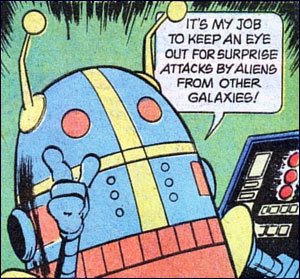
The aforementioned terrible, added-in animation from Sandy Frank (apparently created under contract at Hanna Barbera) almost invariably involved the exploits of 7-Zark-7, a blatant R2D2 ripoff who spent the now murder-free minutes of the program lecturing the audience about stuff like: being nice and responsible, and not murdering people. Bo-ring. The members of the science ninja team, drawn in an alarmingly workmanlike fashion by HB's animators, occasionally appeared to interact with 7-Zark-7 to make it seem like he was part of the series and not the trash can-shaped destroyer of childhood dreams. I mean really, who did the hell did Frank and his people think they were fooling?! I'll tell you who: me. It never occurred to me that 7-Zark-7 didn't belong in the program when I was five years old. Go figure!
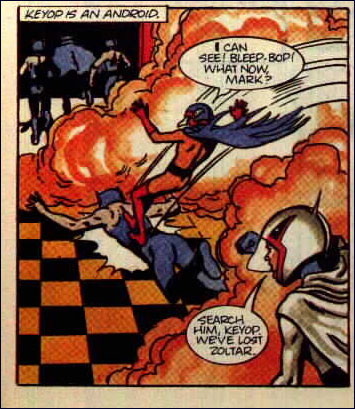
There were a few other changes, too. Everyone who spends too much damn time thinking about these particular dumb old cartoons remembers Keyop, the little kid member of the team, who spoke in weird bleeps and bloops and was apparently some sort of robot. It was never really made clear why Sandy Frank's people altered the character from Gatchaman’s original Jinpei, who was perfectly capable of forming complete sentences. You might've heard that one guy in the back of the dealer's room at your local DoofusCon insisting up and down that the character was dubbed this way because in Japanese, he swears constantly. He's totally foulmouthed, man, it rules. Also, they had to edit Gatchaman because it was so dark and violent, and definitely not a series for kids featuring people fighting robot monsters in bird costumes. These things are, of course, untrue. Frank just took a kid-friendly show and made it friendlier, to satisfy local broadcasting standards and practices. For some reason, this meant turning a little kid into a babbling robot.
Not altogether too long after Battle of the Planets started vanishing from TV Guides from sea to shining sea, a new show called G-Force: Guardians of Space appeared on TBS. The show looked awfully familiar to the then-tiny community of anime dorks, and once again, that name turned up in the credits: Sandy Frank. Right after milking Battle of the Planets until it was dead and then using its still-warm carcass to make hamburgers and wallets, Frank struck a deal with Turner to fill airtime with Gatchaman once more. The newly retitled G-Force, adapted and dubbed from the very same source material by Fred “Gigantor” Ladd, is somewhat more faithful to the original, with no 7-Zark-7, less editing, and way dumber names (Ace Goodheart, Dirk Daring, etc.) G-Force also had one thing that Battle of the Planets lacked: the puppy episode.

The episode seems like typical fare—a giant mole mecha attacks, and G-Force flies off to meet it. But in the chaos, Condor Joe spies a puppy in the wreckage, and overwhelmed with sympathy (he's an orphan, just like that puppy!), he moves to rescue it. He gets a shrapnel fragment to the head for his trouble, and in an amazing scene, both the kid and the fat guy of G-Force blame the orphaned puppy for Joe's injury and try to attack it. To help Joe heal, Gatcha-commander Dr. Nambu straps him into a really dubious centrifuge and tries to shake the shrapnel loose from his brain. Despite the obvious pain to Joe, the doctor keeps turning the speed up, setting up one of the first (and finest) Dr. Nambu is a Dick moments. I mention some others in this piece. The episode is full of bizarre, awkward moments, and even got a squirm-inducing Mystery Science Fanfic written about it. The G-Force version is marginally sillier, but the puppy episode is remarkably potent even in its original Japanese. If you really want to watch it it's here on Youtube, presented in the special way that Russian dubs used to be made (turn English dialogue down a bit, have Russian actors yell over the soundtrack. Вуаля!).
A scant ten years after G-Force, we got Gatchaman ’94 in these parts, Tatsunoko's high-toned, Yasuomi Umetsu-flavored OVA remake, courtesy of Urban Vision. This three-episode joint looked fantastic, but was fleeting and kind of by-the-numbers. Weirdly, despite being pitched to anime fans, the show's dub still had some changed names (Junpei and Ryu became Jimmy and Rocky). You have Harmony Gold to blame for that. The series also featured a really goddamn great faux-Earth, Wind & Fire song—one that Maurice White himself wrote, but left to studio musicians to perform. It's fun to sing along to, and you won't believe how many times the OVA repeats it, over and over, probably to justify studio costs. This OVA served as pretty good nerd-bait for fans of Battle of the Planets, and it actually coincided with a return of Gatchaman to television!
Unfortunately, Gatchaman’s return to TV came in the form of Eagle Riders, a Saban production of Gatcha-sequels Gatchaman II and Gatchaman F. These sequels each ran for a good while, totaling 100 episodes, but they don't get talked about too much among fans of the franchise, even though many of the fine staff that created Gatchaman, like director Hisayuki Toriumi, returned to work on them. That's because… well, just look at the redesigned God Phoenix in Gatchaman II.
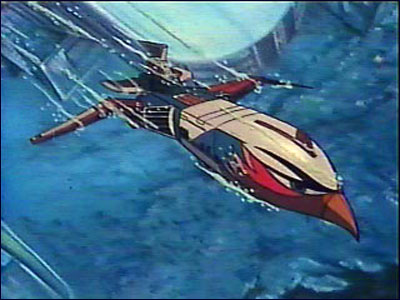
More like God Chicken, huh? Heh heh. The team's vehicle in Gatchaman F, the Gatchaspartan, looks even worse. Story-wise, the team starts by grappling with the loss of fiery second-in-command Joe, but before you know it, Joe comes back from the dead-- as a solar-powered ROBOT! But first they have to beat the evil replacement Joe, who

Yeah, you don't need to bother with Gatchaman II - it's gratifying to see the characters again, of course, but the show is enjoyably dumb at best, boring at worst. Saban's dub is a curiosity (Richard Cansino, who played Joe in the ’94 OVA, graduates to playing Ken! And hey, there's Bryan Cranston dubbin’ anime again), but the show itself is simply lackluster. Gatchaman F’s gimmick, which is to give Ken a lightsaber (you'd think Sandy Frank would've latched on to this), isn't compelling either. After almost twenty years crashing on our shores in some form or another, the supply of Gatchaman was finally exhausted. But then ADV got the rights to it, and yet another version of the classic show was born.
ADV's all-new, all-complete version, packaged with an enormous raft of extras and a zippy, fun new dub that's full of great performances and 70s idioms like “I can dig it” and “far out,” is tons of fun. The dub makes it a lot easier to slog through the middle 30 or 40 episodes, which are pretty enjoyable but still dopey monster-of-the-week fare. The thing is, these DVDs went out of print within a couple of years, and now command hundreds of dollars in the secondary market. Thankfully, Sentai Filmworks have snatched up this classic and made it available again, which is why I'm talking about it in present tense now. If you like classic anime, it's worth getting. The capper? This new set includes Gatchaman ’94, complete with a new dubbed version by ADV's TV cast. I love it when stuff gets dubbed over and over again, don't you? No, you probably don't.
But more than forty years on, what's the best, most effective way to take one of Tatsunoko's most famous brands and rebuild it for a new wave of viewers? Tatsunoko already did a straight-up remake in the 1994 OVA, so that avenue was explored. A new direction was needed—kind of like the new direction that was explored when Ippei Kuri unleashed the original Gatchaman on the world, with its fresh themes of environmentalism, scientific progress, and murdering bad guys with feather shurikens. Kuri's instincts were good, since the original was only slated for 26 episodes but ended up lasting more than 100, not counting those unexceptional sequels. For the brand-new Gatchaman, a 50th anniversary affair by Tatsunoko, some fresh ideas were brought in by series director Kenji Nakamura and scribe Toshiya Ono.
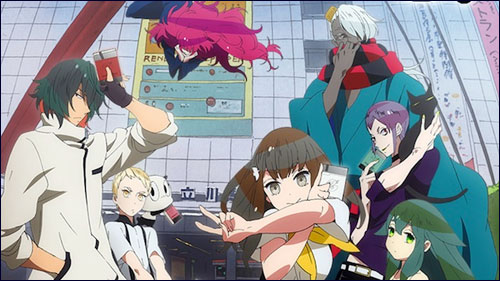
Their approach was simple: do away with the fancy vehicles. Drop the goofy bird costumes—heck, don't even give the bad guy a crazy costume, either. Lose the giant robot monster of the week business. Heck, take the entire comic book superhero aesthetic that powered the original series and put it in the bin. Visually, head in the other direction, drawing from fine art instead of comic art influences. Mix up the group dynamic by making the hero a bubbly teen girl instead of a handsome but driven teen boy, and replace the original's largely episodic style with one single taut story arc. In other words, Nakamura and his staff took the Gatchaman playbook and threw it as far away as they possibly could. Turns out that was a pretty good distance.
Despite that approach, however, the opening episode's events spool out at a frenetic pace: Hajime Ichinose is abruptly told she's part of Team Gatchaman and presented with a mysterious, powerful notebook. It's the show's version of those nifty transmutation watches that O.G. Gatchaman wore, and this point is driven home to perfection when one of Hajime's new cohorts, a serious-looking boy who talks like Toshiro Mifune in Sanjuro, raises one and intones “Bird, go!” resulting in a badass transformation sequence. Yep, this is still a Gatchaman show, after all.
But what a different kind of Gatchaman show Crowds is! The sword-wielding kid, Sugane, transforms into an armored hero that looks more like the studio's titular Karas than any of its classic heroes, and fights using a kind of exhilarating, zero-G iaido. He squares off against MESS, sentient,three-dimensional Piet Mondrian paintings, to the tune of an unforgettably danceable theme song, yet another callback to the original and its chart-topping “Tobe, Gatchaman!” tune. The irresistible Hajime follows Sugane back to Gatchaman's top-secret base, which is a sprawling Boccioni painting; hey, I mentioned the fine art influence, right? The show wears it on its sleeve, even going as far as titling some episodes after specific latter-day fine art movements, like futurism and the abject art movement. Crowds is a show with lofty ambitions, and it lives up to them bracingly often.
At the base, Hajime meets the rest of the team: a bikini-clad sourpuss(Utsutsu); a buoyant, swishy John Waters type (OD, who I couldn't help but hear as “Odie”); the nominal leader of the Gatchaman team, a tiny, loudmouthed alien who looks kinda like a little panda (Paiman); and Condor Joe. Alright, it's not actually the same character, but Crowds’ Jo Hibiki is the new team's most concrete tie-up to the original. He's got Joe Asakura's flowing locks, handsome face, laconic attitude, and angry recklessness. His heroic Gatcha-form is also a bit reminiscent of the original, but is more like a winged oni than a condor. The team turns to guidance from their mysterious spiritual leader, JJ, who delivers abstract poetry in the voice of the original show's Eagle Ken. (Here's where I'd love to etreat American licensor Sentai Filmworks to recruit Casey Kasem for the dub, but he's been in poor health lately.) Every one of them has one of those powerful NOTE notebooks, which facilities both communication and transformation into a superhero. Of course, they're color-coded. Hajime's is white.
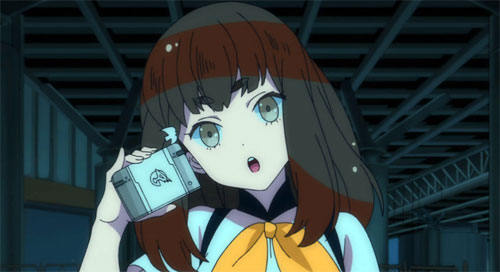
I need to talk about Hajime, because she's an amazing character. Her background is spotty—her mom, appearing only as a tinny echo from the other end of the phone, doesn't seem to mind her sudden membership on team Gatchaman. But Hajime's vibrant and friendly, and her attachment to fancy notebooks makes her acquisition of a NOTE humorous. She's guileless, boundlessly friendly, and irrepressibly curious. After watching Sugane violently engage the MESS entities, she opts to try communicating with them, and it works out. She's open-minded to the point that even the series heavy is taken aback when she appears and tries to start a friendly conversation. Hajime's a genki heroine not because it's expected of her, but because it works for her.
The show's conflict revolves around a social network called GALAX and the people who use it, nicknamed GALActors. The network's founder and operator, Rui Ninomiya, is an interesting guy—he wears a dress to keep the public away from his real identity, but the dress rarely comes off, even in private. His online alias is LOAD; I guess calling him MOOT would be a little too on-the-nose. He's got an interesting idea for how to utilize GALAX—along with his AI assistant, Leader X, Rui's selected a hundred users and bestowed special powers, called CROWDS, that allow the users to respond quickly to public crises and disasters. It's crowdsourced disaster relief, and it's a nifty concept; where the original's Dr. Nambu took the youthful idealism of his heroes and used it as rocket fuel for his vision of justice and progress, Crowds’ Rui discovers a way to weaponize the unrestrained, raging id of the internet itself. But Rui is hampered by a shadowy benefactor named Berg Katze.
You can see the angles, right? Nakamura and company toss out the costumes, but in a million other ways, Gatchaman Crowds is still Gatchaman through and through. Depending on your feelings about old-school Gatchaman, however, you may find the show polarizing. I've talked to fans invigorated with this new-look approach, but I've also talked to fans who think Gatchaman Crowds is undeserving of the fine Gatchaman name, which apparently should only be reserved for the very best bird-themed superhero cartoons. I love the show, from its magnetic characters to its unique visuals to its relentless, clever callbacks to the old series. I'm already working my way through it a second time, to try and soak up some more of its visual references—I know next to nothing about modern art, but I can see more stijil-esque stuff poking out of the backgrounds, and the CROWDS physical entities look more than a little abectionist. I love it when anime teaches me about the world!
After all that, what's left? Well, team Gatchaman have had a number of humorous cameos in the Yatterman series, both in the Royal Revival OVA (which Sentai is also releasing!) and the 2008 TV series, which you can watch on Anime Sols. There's a great extended gag about the team in the Nurse Witch Komugi OVA, which is an old favorite of mine. After a CG film by the studio Imagi was derailed by bankruptcy, the team was finally brought back for a gag flash cartoon called Good Morning Gatchaman, which is pretty great—shades of stuff like Harvey Birdman, I think. And of course, there's Nikkatsu's high-profile Gatchaman film, which just recently came out on home video in Japan. I haven't explored those waters yet, because of what a Japanese twitter buddy said about the movie. “This is really shit movie!” she commented. “You must never watch!” Welp, sounds like yet another anime feature film adaptation has turned out just as expected.
Through it all, I remain excited for Gatchaman, both because of the recent re-release of the puppy episode (and some other episodes, I guess) and of the sheer inventiveness of Gatchaman Crowds. The show is incredibly fresh and vivid, yet intersects with the original Gatchaman in a thousand awesome ways. It's full of interesting ideas, like the gamification of improving society, and even if you're put off by the extent of the departure, it's worth a look just for Mamoru Miyano's inspired, looney-tunes performance as Berg Katze.
Underneath Crowds’ hood is still the classic Tatsunoko superheroism-- only stripped down and reassembled in collage by its creative staff, like a Double D and Steinski dance remix, resulting in what just might be the boldest, most inventive commentary about the power of social media yet created. The ending's kind of a fumble—half recap episode, and half aborted final battle that we never get to see—but there's both a newly-issued director's cut of the series finale on Japanese home video (which we'll hopefully get on Sentai's US Crowds release) and another season promised by Tatsunoko. As crazily divergent from the original as Gatchaman Crowds might seem, the team of Hajime, Joe, Utsutsu, OD, and Painan are ultimately still always five, acting as one: dedicated, inseparable, and invincible! Unless there's a puppy involved.discuss this in the forum (49 posts) |